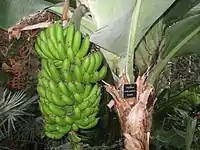ensete
See also: Ensete
English
WOTD – 29 December 2017


The ensete (Ensete ventricosum), also known as the Abyssinian banana, Ethiopian banana, or false banana. Because the fruit of the plant is not very palatable, it is its root that is eaten.
Etymology
From Ge'ez እንሰት (inset, “the false banana Ensete ventricosum; ensete”).
Pronunciation
- (Received Pronunciation, General American) IPA(key): /ˈɛnsət/
- Hyphenation: en‧sete
Noun
ensete (plural ensetes)
- Ensete ventricosum, a species of flowering plant in the banana family Musaceae, the root of which is used for food and other purposes.
- Synonyms: Abyssinian banana, Ethiopian banana, false banana
- 1790, [James Bruce], “Ensete”, in Select Specimens of Natural History, Collected in Travels to Discover the Source of the Nile, in Egypt, Arabia, Abyssinia, and Nubia, volume V, Edinburgh: Printed by J. Ruthven, for G. G. J. and J. Robinson, Paternoster-Row, London, OCLC 220660485, pages 37–38:
- [T]he figs of the Enſete are not eatable; they are of a tender, ſoft ſubstance; watery, taſteleſs, and in colour and conſiſtence ſimilar to a rotten apricot; they are of a conical form, crooked a little at the lower end, about an inch and a half in length, and an inch in breadth where thickeſt.
- 1797, “MUSA, the plantain-tree”, in [Colin Macfarquhar], editor, Encyclopædia Britannica; or, A Dictionary of Arts, Sciences, and Miscellaneous Literature; [...] The Third Edition, in Eighteen Volumes, Greatly Improved, volume XII (Mill to Negropont), Edinburgh: Printed for A[ndrew] Bell and C[olin] Macfarquhar, OCLC 166588720, page 469, column 1:
- Were it not for the enſete, therefore, the Galla would have ſcarce any vegetable food. Mr [James] Bruce thinks that the enſete may have been cultivated in ſome of the gardens of Egypt about Roſetto, but that it was not a native of the country.
- 1843, [Karl Wilhelm Isenberg; Johann Ludwig Krapf]; James Macqueen, chapter III, in Journals of the Rev. Messrs. Isenberg and Krapf, Missionaries of the Church Missionary Society, Detailing Their Proceedings in the Kingdom of Shoa, and Journeys in Other Parts of Abyssinia, in the Years 1839, 1840, 1841, and 1842. To which is Prefixed, a Geographical Memoir of Abyssinia and South-eastern Africa, by James M‘Queen, Esq. Grounded on the Missionaries’ Journals, and the Expedition of the Pacha of Egypt up the Nile, London: Seely, Burnside, and Seely, Fleet Street, London, OCLC 680429377, page 79:
- On the way I saw, for the first time, Enset, a nice plant, which is described in [James] Bruce's Travels. The Abyssinians use it in baking bread, which is wrapped in it, and gives to it a particular scent, which I do not like.
- 1886, H[arry] H[amilton] Johnston, “Sir John Kirk at Home”, in The Kilima-Njaro Expedition. A Record of Scientific Exploration in Eastern Equatorial Africa. And a General Description of the Natural History, Languages, and Commerce of the Kilima-Njaro District, London: Kegan Paul, Trench, and Co., 1, Paternoster Square, OCLC 156194682, page 39:
- Here, among his Cycads and his Orchids, his Ensetes and his Dracænas, spade in hand, a wideawake hat on his head, a rare flower in his button-hole, and rustic contentment irradiating his face—here, amid scenery which typifies a botanist's paradise, Sir John Kirk is emphatically At Home.
- 2004, Stephen B. Brush, Farmers’ Bounty: Locating Crop Diversity in the Contemporary World (Yale Agrarian Studies Series), New Haven, Conn.; London: Yale University Press, →ISBN:
- Another instance of religious influence on diversity of cultivars is found in Ethiopia, where the Ari people cultivate ensete, a relative of the banana (Shigeta 1990). Ensete leaves are used for wrapping, thatching, ground cover for sitting, containers, dresses, ornamentation at funerals and weddings, and shading from sun and rain.
Alternative forms
Translations
species of flowering plant in the banana family Musaceae
|
|
References
- “ensete” in Merriam–Webster Online Dictionary.
Further reading

This article is issued from Wiktionary. The text is licensed under Creative Commons - Attribution - Sharealike. Additional terms may apply for the media files.